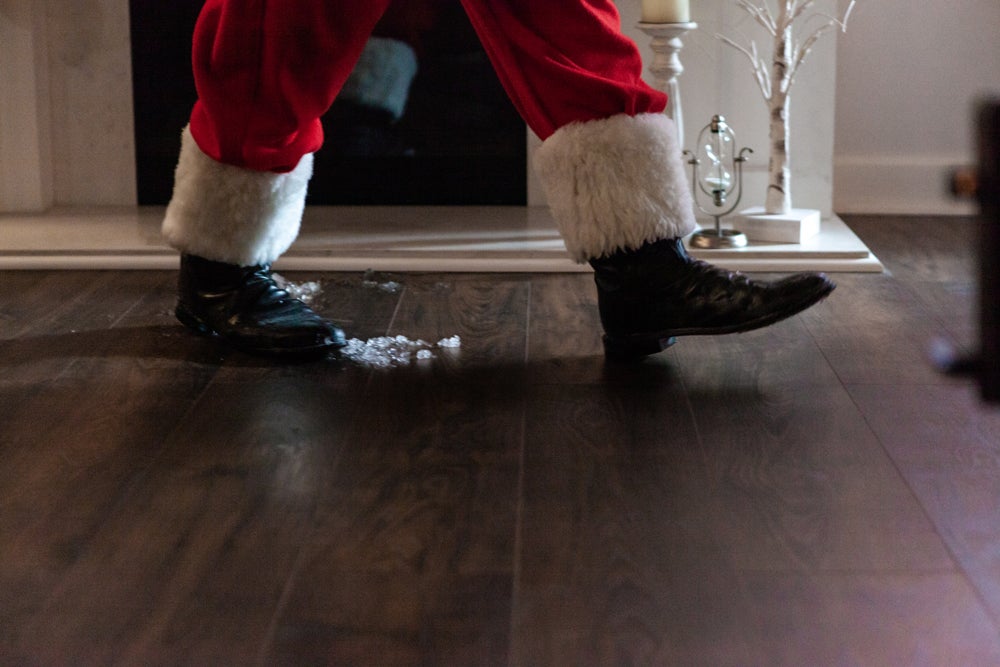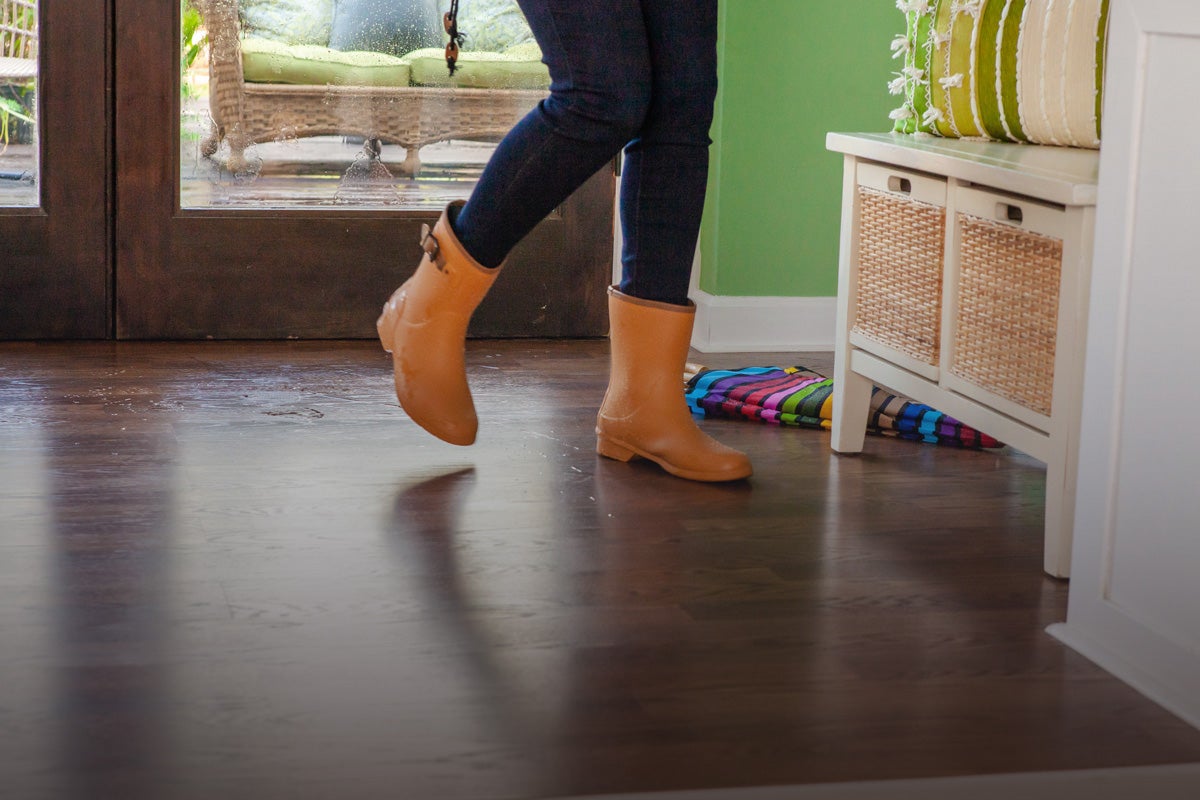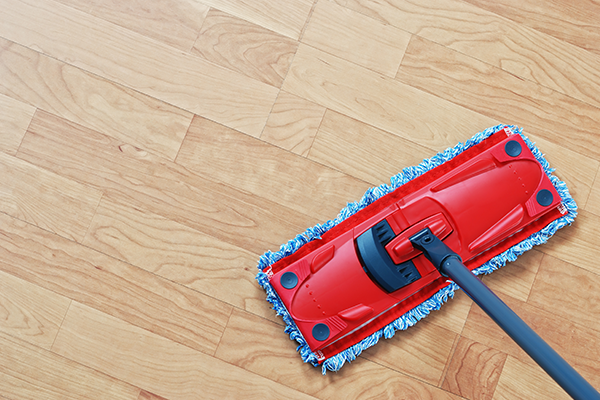
It’s freezing cold outside, but you’re cozy indoors blasting the heat. You walk across your wood floor to check the thermostat and notice the floorboards beneath you creaking and groaning. They weren’t doing that before, you think. Do I suddenly live in an old pirate ship?
It’s not your imagination. But there’s a clear explanation: winter humidity swings – dry, heated air pulling moisture from your flooring and making it contract. Then, you track in snow and slush that seeps into the floorboards, which causes swelling, buckling, and even mold.
This cycle doesn’t just affect hardwood. Laminate can warp, vinyl loosens, and tile can eventually crack. But the good news is that you don’t have to simply accept this each winter season. With these humidity control tips for floors during winter, you’ll be able to maintain the perfect humidity balance inside and keep your floors flawless year-round.
Why Winter Humidity Damages Floors
During winter, the air outside is already cold and dry. Inside, homeowners crank their heating systems to full blast, which strips the air of what little moisture was left. This causes numerous problems, but can especially affect different flooring types.
Dry Air Leads to Shrinking & Gapping
Once your heating system zaps the remaining moisture from the air, your flooring feels the effects. If you have hardwood floors, the planks contract and leave gaps between the boards. Laminate and vinyl won’t shrink the same way but can become brittle.
Too Much Moisture Leads to Warping & Buckling
Then there’s the complete opposite problem – spikes of moisture. Wet boots, melting snow, and steam from kitchen and bathroom activities introduces a shock of humidity to your floors. Wood floors can swell and buckle, laminate edges may lift, and tile grout absorbs the moisture, potentially causing cracks over time.

Humidity Fluctuations Cause Long Term Damage
Having too dry or too humid air over a long period of time isn’t necessarily as bad as a rapid swing. If your floors keep running through cycles of expansion and contraction, they’ll weaken over time. This is the primary cause of warping and cracks during the winter months.
Ideal Humidity Levels for Flooring During Winter
Shown visually, your humidity levels probably look like a roller coaster. This wreaks havoc on your floors – so what’s the magic number to keep your indoor humidity to protect your floors during winter?
Ideally, you want your indoor humidity range to fall between 35 to 55 percent unless recommended otherwise by the manufacturer. It’s low enough to prevent mold and moisture, but high enough to stop wood and other flooring types from drying out.
How to Check Indoor Humidity
The easiest way to monitor your home’s humidity is with a hygrometer. These are simple devices you can find often for less than $20 at a local hardware store. You can also check to see if your thermostat already has a built-in humidity sensor. Many modern smart thermostats can even adjust your home’s HVAC system settings to maintain proper humidity levels automatically.
Practical Humidity Control Tips for Winter
You want peace of mind this winter when it comes to your flooring? All you need is to employ a few simple techniques to keep your home’s humidity in the perfect range.
1. Keep Humidity Levels Stable
If you see your humidity levels regularly drop below 35 percent, you need a humidifier. Whole-home humidifiers built into HVAC systems are the easiest long-term fixes, but you can find affordable portable room humidifiers to target specific areas.
Any time you cook, shower, or dry clothes, your humidity can climb too high. Use your exhaust fans any time you use the kitchen or bathrooms to keep things balanced. And if things outside are too extreme (this applies for both cold and hot days), avoid letting the outdoor air inside.
2. Prevent Moisture Damage from Snow & Rain
Keeping excess winter moisture outside where it belongs is as simple as laying down absorbent mats. Install these at all entrances to catch any slush, ice, or road salt before they ever touch your flooring.
We also love to recommend a boot tray for shoe removal and a no-shoes-indoors policy. Shoes take the biggest beating from winter weather, so keeping them contained at entrances is great for both your floors and your sanity.
If you notice any wet spots – from filthy shoes or even an overexcited pet, clean it up ASAP. Moisture left sitting on the floor seeps in and can cause damage very quickly.
3. Protect Hardwood & Laminate from Drying Out
If you’re leaving your home for several days, don’t turn the heat all the way off. Keep it running at the lowest settings but ensure the indoor air won’t go through a massive shift in temperature when you come home. Sudden changes like these can stress your hardwood and laminate floors like none other.
You can also add rugs in high-traffic zones – particularly in hallways, outside of bathrooms, etc. They’ll add warmth and a touch of décor and prevent scratches and reduce direct exposure to dry air.
One more thing: try to avoid wet mopping. Hardwood and laminate alike suffer from standing water, so only use a damp mop and use only manufacturer recommended floor cleaners. 
4. Manage High-Humidity Problem Areas
Have a basement or another naturally humid area in your home? You’ll want to keep a dehumidifier on hand to keep indoor moisture levels in check during winter. You should also check regularly for leaks or condensation – doors, windows, and HVAC vents often introduce unwanted moisture. If you notice any collecting near your walls or in spots where there shouldn’t be moisture, you probably want to investigate.
For tile flooring, always keep your grout sealed well. Applying grout sealant before the winter cold sets in is a great way to prevent grout lines from absorbing water, swelling, and causing cracks down the road.
Upgrade Your Floors for Humidity Resistance
If your home has suffered countless years of winter damage, you might want to rethink your flooring – it could be time for an upgrade. Some materials simply handle humidity shifts better than others by reducing the risk of swelling, warping, or cracking:
- Engineered Hardwood: This flooring type is designed to withstand seasonal expansion and contraction far better than traditional hardwood.
- Luxury Vinyl Plank: LVP is fully waterproof and resistant to humidity changes. Homeowners in particularly moisture-prone areas with harsh winters love it.
- Porcelain Tile: These tiles are nearly impervious to humidity fluctuations. This makes them perfect for kitchens, bathrooms, and entryways.
If you aren’t ready to replace your floors quite yet, controlling your indoor humidity during winter will protect your floors for years to come. But if you think the time is right, reach out to the team at Empire Today®. Our FREE in-home flooring estimate will tell you everything you need to know about the ideal flooring for your home. Contact us today!
Keep Winter from Ruining Your Floors
Looks like a little preparation is all it takes to protect your floors from winter humidity. Here’s a rapid recap of what we discussed today:
- Monitor humidity using a hygrometer
- Place humidifiers or dehumidifiers strategically
- Use mats and boot trays at entrances to keep moisture off your floors
- Seal hardwood and tile floors to prevent moisture damage
- Keep your indoor heating consistent and avoid drastic temperature swings
- Clean up any standing water and investigate condensation spots ASAP
If you follow these tips, you'll help protect your flooring against the worst winter weather throws your way.
Want to learn more about protecting your flooring year-round? The Empire® blog has you covered – check out some of our latest articles today!
